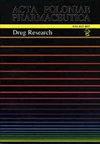Formulation, characterization, and in vitro evaluation release nimesulide from different rectal suppository bases
IF 0.4
4区 医学
Q4 PHARMACOLOGY & PHARMACY
引用次数: 0
Abstract
Nimesulide is a poorly water-soluble, non-steroidal anti-inflammatory drug for both systemic and topical application. The aim of the study was to assess the influence of the type of base and surfactants (Tween80, Span80, soy lecithin, sodium lauryl sulphate) on drug release from rectal suppositories. Suppositories were prepared in the Unquator® using Cacao butter, Witepsol H15 and PEG1500:PEG400 as a base. The physicochemical properties of the prepared suppositories were in accordance to the Pharmacopoeia’s requirements. In vitro dissolution profile of the formulations was evaluated using USP apparatus 1. It has been shown that most of the nimesulide was released from suppositories prepared on PEG base. Addition of 2% surfactant to lipophilic base suppositories, significantly increased the amount of nimesulide released from all the investigated formulae. Among the formulations containing surfactants, only Witepsol H15 with Span 80 released a nearly complete drug during 210 minutes. The results indicate that the First-Order model is the best fit with the nimesulide in-vitro release from lipophilic suppositories, while the Higuchi model - to the PEG suppositories. The drug release kinetics from suppositories showed that the Cacao butter bases adequately fit data for zero-order kinetics model, while the Higuchi model - for the PEG suppositories.尼美舒利的配方,特性和体外评价释放尼美舒利从不同的直肠栓剂基础
尼美舒利是一种水溶性差的非甾体抗炎药,可全身和局部应用。本研究的目的是评估碱和表面活性剂(Tween80、Span80、大豆卵磷脂、十二烷基硫酸钠)的类型对直肠栓剂药物释放的影响。栓剂在Unquator®中以可可脂、Witepsol H15和PEG1500:PEG400为基质制备。所制栓剂的理化性质符合药典要求。采用USP仪器1评价制剂的体外溶出度。研究表明,大部分尼美舒利从PEG基栓剂中释放出来。在亲脂碱栓剂中加入2%的表面活性剂,可显著提高尼美舒利的释放量。在含有表面活性剂的制剂中,只有含有Span 80的Witepsol H15在210分钟内释放出接近完整的药物。结果表明,一阶模型最适合尼美舒利在亲脂栓剂中的体外释放,而Higuchi模型更适合PEG栓剂。栓剂的药物释放动力学表明,可可脂基完全适合于零级动力学模型,而PEG栓剂的模型适合于Higuchi模型。
本文章由计算机程序翻译,如有差异,请以英文原文为准。
求助全文
约1分钟内获得全文
求助全文
来源期刊
CiteScore
0.80
自引率
0.00%
发文量
74
审稿时长
6-12 weeks
期刊介绍:
The international journal of the Polish Pharmaceutical Society is published in 6 issues a year. The journal offers Open Access publication of original research papers, short communications and reviews written in English, in all areas of pharmaceutical sciences. The following areas of pharmaceutical sciences are covered: Analysis, Biopharmacy, Drug Biochemistry, Drug Synthesis, Natural Drugs, Pharmaceutical Technology, Pharmacology and General.
A bimonthly appearing in English since 1994, which continues “Acta Poloniae Pharmaceutica”, whose first issue appeared in December 1937. The war halted the activity of the journal’s creators. Issuance of “Acta Poloniae Pharmaceutica” was resumed in 1947. From 1947 the journal appeared irregularly, initially as a quarterly, then a bimonthly. In the years 1963 – 1973 alongside the Polish version appeared the English edition of the journal. Starting from 1974 only works in English are published in the journal. Since 1995 the journal has been appearing very regularly in two-month intervals (six books a year). The journal publishes original works from all fields of pharmacy, summaries of postdoctoral dissertations and laboratory notes.

 求助内容:
求助内容: 应助结果提醒方式:
应助结果提醒方式:


